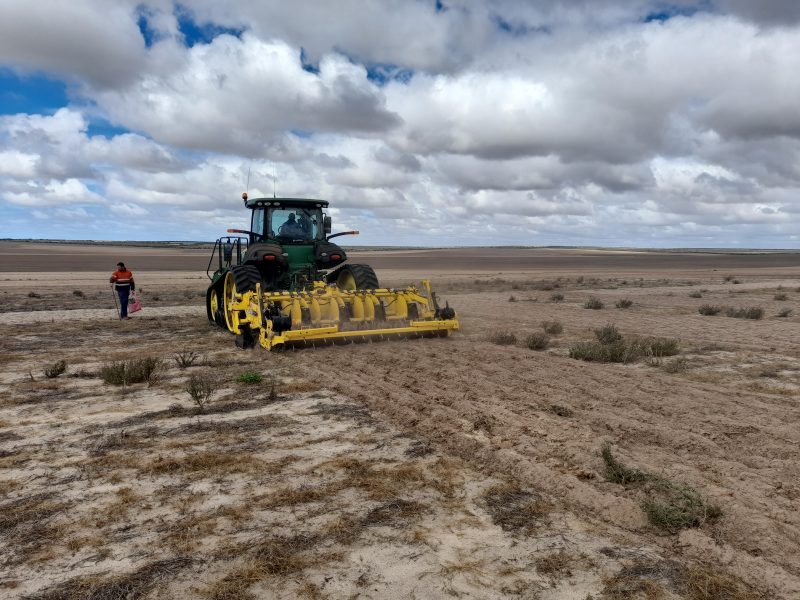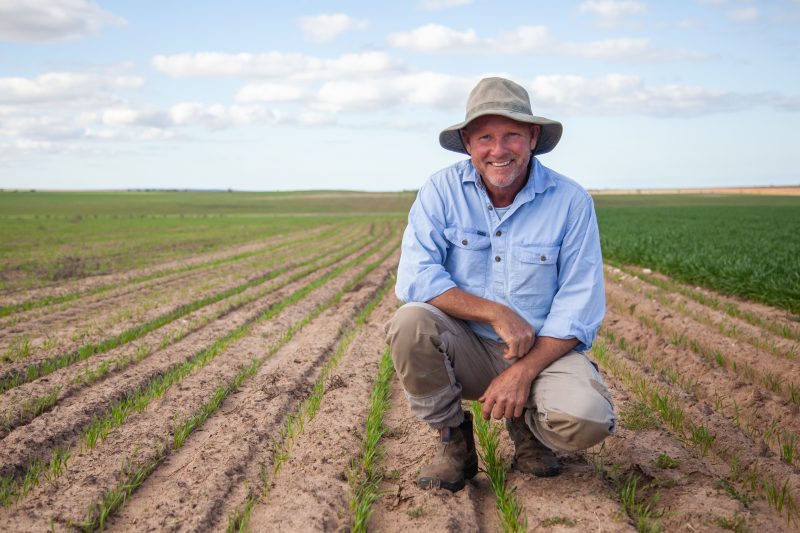Building drought resilience by scaling out farming practices that will enhance the productive capacity of sandy soil landscapes
Summary
This project will enhance the drought resilience of farmers who manage 3 million hectares of sandy soils in the low-medium rainfall landscape of southeast Australia.
This will be achieved through the adoption of practices that enhance the productive capacity of sandy soils by overcoming constraints including water repellence & compacted layers that prevent root growth & access to moisture & nutrients.
Practices proven to work in small-scale trials will be scaled-out at 16 demonstration sites to build farmers’ confidence across an extensive landscape of the Eyre Peninsula, Upper Yorke Peninsula, Mallee & Southeast regions.
Case studies will be used to document outcomes from sites, with this information extended directly to 400 farmers through 17 events implemented by a consortium of grower groups. The project will also disseminate case studies using a digital extension hub & established social media networks to ensure maximum impact with farmers managing sandy soils across Australia.
Project partners:
The consortium is made up of 4 grower groups and a university:
- Ag Innovation & Research Eyre Peninsula (AIR EP)
- Mallee Sustainable Farming (MSF)
- MacKillop Farm Management Group (MFMG)
- Northern Sustainable Soils (NSS)
- University of South Australia
Delivery partners include:
- PIRSA
- GRDC
- CSIRO
- Frontier Farming Systems
- Trengove Consulting
- Soil Function Consulting
- Alluvio Pty Ltd
The project has been funded through the Future Drought Fund’s Drought Resilient Soils and Landscapes grants program and the Grains Research & Development Corporation, and is supported by the SA Drought Resilience and Adoption Hub.
Useful resources:
CASE STUDIES
A series of 16 case studies have been produced by this project, with farmers located across south eastern Australia.
Case study 1: Venning, Bute, Yorke Peninsula SA
Case study 2: Venning, Bute, Yorke Peninsula SA
Case study 3: Skeer, Wattle Range, South East SA
Case study 4: Hurrell, Naracoorte, South East SA
Case study 5: Ranford, Arno Bay, Eyre Peninsula SA
Case study 6: O'Brien, Kyancutta, Eyre Peninsula SA
Case study 7: Williams, Streaky Bay, Eyre Peninsula SA
Case study 8: Dolling, Kielpa, Eyre Peninsula SA
Case study 9: Oswald, Mt Damper, Eyre Peninsula SA
Case study 10: Daniell, Poochera, Eyre Peninsula SA
Case study 11: Gosling, Yaapeet, Mallee Vic
Case study 12: Cowangie, Mallee Vic
Case study 13: Stephens, Younghusband, Mallee SA
Case study 14: Grant, Chinkapook, Mallee Vic
SOILS HUB
Check out the Soils Hub to view 3D virtual soil pits and handy videos that describe how to easily test for soil constraints in your own paddocks. There are soil pits from across south eastern Australia.
FACT SHEETS
A series of fact sheets have been produced in an earlier GRDC funded project: Increasing production on sandy soils in low and medium rainfall areas of the Southern Region, GRDC Project CSP00203.
Seeding sandy soils - Managing water repellence at seeding: moisture access strategies
Soil wetter - Managing water repellence at seeding: soil wetting agents
Inclusion ripping technology - Understanding passive inclusion ripping
Ripping technology - Technology considerations for cost-effective subsoil loosening
Check out the Sandy Soil App produced as part of the GRDC Sands Impact project, for all the trial results across all sites and regions.
Project Summary
This project aimed to enhance the drought resilience of farmers who manage 3 million hectares of sandy soils across the low-medium rainfall landscape of southeast Australia. This has been achieved through the adoption of practices that enhance the productive capacity of sandy soils by overcoming constraints including water repellence and compacted layers, that prevent both root growth, access to moisture and nutrients. Practices proven to work in small scale trials were scaled out at 16 demonstration sites to build farmers’ confidence across an extensive landscape of the Eyre Peninsula, Upper Yorke Peninsula, Mallee and Southeast regions. The sites were monitored throughout the project with data collected to determine the effectiveness of different practices.
16 case studies were developed to document outcomes from sites. The project engaged directly with 1638 people attending 52 extension events including Sandy Soil Masterclasses, crop walks, field days, research updates and workshops across the project area. Indirect engagement occurred with 79,795 people across the project footprint via 56 communications materials, including research articles, digital platforms (Agriknow, Soils Hub), various social media platforms and pages, e-newsletters and media articles.
The project was delivered by a consortium of grower groups (Ag Innovation & Research Eyre Peninsula, Mallee Sustainable Farming, MacKillop Farm Management Group and Northern Sustainable Soils) in conjunction with delivery partners PIRSA, Uni SA, Frontier Farming Systems, Trengove Consulting, Soil Function Consulting, CSIRO (technical support, masterclass delivery), Alluvio Pty Ltd (case study development) and Coutts J&R (monitoring and evaluation). The project was also supported with a cash contribution from Grains Research & Development Corporation to broaden the reach of the extension program.
The project was managed by Ag Innovation & Research Eyre Peninsula, hosting bi-monthly online project team meetings to keep everyone updated and on track, as well as annual face to face meetings to share results and build capacity within the project team. This project also collaborated with two other Future Drought Fund projects: Building drought resilience with landscape scale remediation of saline land (Soil and Landscape program) and Robust ground cover to enable resilient low rainfall mixed farms (FDF Innovation program) to reduce duplication and maximise resources.
In terms of project effectiveness, 85% of all participants indicated they had changed the way they manage their farming practices to better manage sandy soils. Farmers indicated that many of their sandy soil constraints had improved or stopped getting worse after participating in the project. Examples provided included changes to delving, deep ripping, and liming rates or techniques that resulted in increased yields and improved ground cover. Farm trials/demos were the most used and useful source of information for farmers, with 100% agreeing (85% strongly agreeing) that viewing on-farm trials and demos in their neighbourhood is essential in evaluating and adopting new practices. All farmers agreed that the on-farm research linked to this project seemed to offer some practical solutions for managing low production sandy soils on their farm, and all agreed there is significant opportunity to better manage soils on their farms in future. The project engagement with farmers through field days/sticky beak days was seen as a highly effective method of providing information. The networking opportunities provided by the project were valued, with most farmers finding the information they had gained from other farmers/neighbours and advisers highly useful, with 85% agreeing (23% strongly agreeing) that talking to other farmers about new farming practices is one of the most reliable sources of information.
You Might Also Like
Young Farmer Peer to Peer Learning Lower EP 2025
AIR EP will establish a group comprised of Lower Eyre Peninsula young farmers (~18-35 years). This group will participate in three field events/workshops featuring speakers on topics that build agricultural,…
Learn MoreBuilding resilience – Break Crop Suitability Across Landscapes (Stage 2)
Upper North Farming Systems and AIR EP have worked to bring this common theme across the 3 farming groups and 4 Node regions together into the one project in 2024.…
Learn MoreRisky decisions and addressing soil constraints on EP
This project has two key objectives that address the priorities of the SA Drought Hub 1. Arming farmers and advisors with tools to assist in decision making that considers risk…
Learn MoreGrowing lentils on challenging soils on Eyre Peninsula
A new 3-year project has been funded by GRDC to explore growing lentils on ‘challenging’ soils across EP. The project, led by AIR EP will fund 4 trials per year,…
Learn MoreDe-risking the sowing program on EP in 2025
SA Drought Hub Project Page
Learn MoreUnderstanding herbicide residue on challenging soil types within the southern region
To develop a better understanding of the nature and scope of herbicide residues issues, paddock surveys will be conducted in soil types of concern in SA. To determine phyto-toxicity thresholds,…
Learn MoreEyre Peninsula internship in applied grains research 2026
To improve the capacity of grains research, development and extension in the Eyre Peninsula region through the employment of an annual intern within local research organisations in 2026. Hosted by…
Learn MoreSustainable Agriculture: Driving growth through innovation and climate responsive practices.
The Eyre Peninsula Sustainable Agriculture Program brings together Agricultural Innovation & Research Eyre Peninsula (AIR EP), the EP Landscape Board, key researchers, industry specialists, and local organisations to deliver a…
Learn MoreImproving crop phosphorus supply on highly calcareous soils using novel sources
This project will develop integrated solutions to improve the delivery of P in challenging calcareous soils with multiple constraints. Those solutions will be developed in a farming systems context so…
Learn MoreCarbon Outreach Project
The Eyre Peninsula Landscape Board (EPLB) is one of eight regional Boards collaborating to deliver the overarching project titled SA Carbon Outreach: Trusted advisors empower all SA land managers. The…
Learn More

